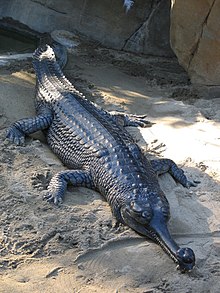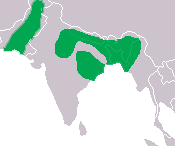Gharial
| Gharial Temporal range: 33.9–0 Ma Late Eocene – Recent |
|
|---|---|
 |
|
| Scientific classification | |
| Kingdom: | Animalia |
| Phylum: | Chordata |
| Class: | Reptilia |
| Order: | Crocodilia |
| Family: | Gavialidae |
| Genus: | Gavialis |
| Species: | G. gangeticus |
| Binomial name | |
|
Gavialis gangeticus (Gmelin, 1789) |
|
 |
|
The gharial (Gavialis gangeticus), also known as the gavial, and the fish-eating crocodile, is a crocodilian of the family Gavialidae, native to the northern part of the Indian Subcontinent. The global wild gharial population is estimated at fewer than 235 individuals, which are threatened by loss of riverine habitat, depletion of fish resources, and entanglement in fishing nets. As the population has declined drastically in the past 70 years, the gharial is listed as Critically Endangered on the IUCN Red List.
The gharial is one of the longest of all living crocodilians, measuring up to 6.25 m (20.5 ft), though this is an extreme upper limit, as the average adult gharial is only 3.5 to 4.5 m (11 to 15 ft) in size. With 110 sharp, interdigitated teeth in its long, thin snout, it is well adapted to catching fish, its main diet. The male gharial has a distinctive boss at the end of the snout, which resembles an earthenware pot known in Hindi as ghara. The gharial's common name is derived from this similarity.
Gharials once inhabited all the major river systems of the Indian Subcontinent, from the Irrawaddy River in the east to the Indus River in the west. Their distribution is now limited to only 2% of their former range. They inhabit foremost flowing rivers with high sand banks that they use for basking and building nests. They usually mate in the cold season. The young hatch before the onset of the monsoon.
The gharial is one of three crocodilians native to India, the other two being the mugger crocodile and the saltwater crocodile.
The gharial is characterised by its extremely long, thin jaws, which are regarded as an adaptation to a primarily piscivorous diet. Males reach up to 6 m (20 ft) with an average weight of around 160 kg (350 lb).
It is dark or light olive above with dark cross-bands and speckling on the head, body and tail. Dorsal surfaces become dark, almost grey-black, at about 20 years of age. Ventral surfaces are yellowish-white. The neck is elongated and thick. The dorsal ridges are more or less restricted to the median regions of the back. The fingers are extremely short and thickly webbed. Males develop a hollow bulbous nasal protuberance at the tip of the snout upon sexual maturity. The name gharial is derived from the resemblance of the nasal growth to an earthen pot known locally as 'ghara'. Gharials are the only extant crocodilian with visible sexual dimorphism. Although the function of the nasal boss is not well understood, it is apparently used as a visual sex indicator, as a sound resonator, or for bubbling or other associated sexual behaviours.
...
Wikipedia

